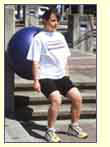  |
|
|
|
|
|
|
|
3-D PHYSIO BALL TRAINING
Tired of doing weights or bored with your gym workout? Looking for something to add to your
training regime that is challenging and works several systems at once? Consider the physio
ball to help get and keep you Fit to Play in three dimensions. The physio ball is
versatile, practical and affordable. Training with the physio ball can strengthen the core
muscles of the body in all directions of motion.
|
3 Dimensional Training
Tennis training requires power, co-ordination and agility in three planes of movement.
Multidirectional training requires movements passing through multiple planes of motion or
using numerous joints and groups of muscle. This training helps improve firing efficiency
of co-contractors and stabilizing muscles giving you more control of your strength.
Traditional strength exercises and aerobic equipment often constrain us to a single plane
of movement.  For example, exercises like bicep curls involve a single
joint and are in one plane of movement. Using the treadmill, stationary bike and step
machines also work the body in one plane of movement. Normal daily movements cause the body
to rotate around three different axes / planes at one time. Real life is three dimensional
and the activities of daily living and sporting activities challenge the body to
dynamically react to the moving, changing environment we live and play in. For example, exercises like bicep curls involve a single
joint and are in one plane of movement. Using the treadmill, stationary bike and step
machines also work the body in one plane of movement. Normal daily movements cause the body
to rotate around three different axes / planes at one time. Real life is three dimensional
and the activities of daily living and sporting activities challenge the body to
dynamically react to the moving, changing environment we live and play in.
Human movement outside a single plane is a complex blend of muscles and joints working in 3
dimensions to shorten, lengthen, stabilize and provide optimum function. The ball is a
simple training tool for tennis as it challenges the body in 3 dimensions and strengthens
the core muscles.
|
What is the Core?
The core muscles are those that help to protect your back and pelvis against injury. It
consists of 4 main muscles - the transversus abdominus (lower abdominals), multifidus
(deep, small muscle of the back), the pelvic floor muscles and the diaphragm. These muscles
work together to form a corset-like cylinder of support to the back and pelvis. While the
core muscles work to stabilize the torso, the larger and longer muscles of the body can
then work optimally. These larger muscles provide the links between the upper extremities
and the lower extremities while the core provides a strong, stable platform of which to
work off.
|
|
Benefits of 3-D Ball Training
|
|
• improve posture
• improve muscle strength and endurance
• improve athletic performance
• improve joint and muscle position sense (kinesthetic awareness)
• improve ability to dissociate upper and lower extremities
• improve movement efficiency
• improve dynamic balance
|
|
|
Ball Precautions
|
|
|
|
• avoid placing ball near heat or in direct sunlight
• avoid sharp objects and jewellery
• start gradually and get a feel for the ball before progressing
• physical check-up for individuals new to exercise
|
Before You Start
Choosing the proper ball size is important. When you sit on the ball, knees should be bent
to 90 degrees with your feet flat on the floor. The hips should be bent to almost 90
degrees but should be resting equal to or slightly higher than the height of your knees.
|
|
|
CONTINUE 
|
|
|
|
|
